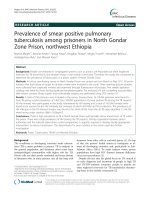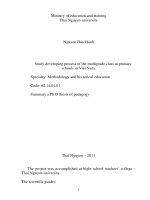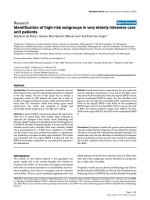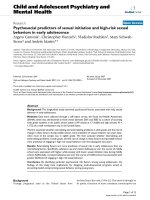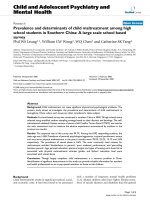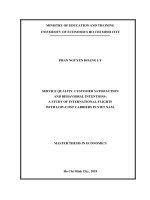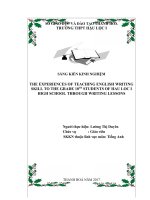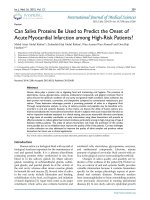Sero prevalence of covid 19 i high risk population in viet nam
Bạn đang xem bản rút gọn của tài liệu. Xem và tải ngay bản đầy đủ của tài liệu tại đây (243.92 KB, 35 trang )
iew
ed
Title: Sero-prevalence of SARS-CoV-2 in high-risk populations in Vietnam
Authors:
Tasnim Hasan1,2 MBBS
Pham Ngoc Thach3 PhD
Nguyen Thu Anh2 PhD
pe
er
re
v
Le Thi Thu Hien2 MIPH
Le Van Duyet3 PhD
Dang Thi Thuy3 MD
Van Dinh Trang3 PhD
Pham Ngoc Yen2 MS
Nguyen Viet Ha2 BPharm
Tran Linh Giang2 BPharm
Nguyen Thi Cam Van2 MD
Truong Quang Viet4 MD
tn
Dao Huu Than4 MD
ot
Nguyen Trung Thanh2 BSPH
Le Thanh Chung5 MD
Truong Tan Nam5 MD
rin
Vo Trung Hoang6 MD
Le Thanh Phuc7 MD
ep
Nguyen Thanh Thao8 MD
Luu Van Vinh8 MPH
Pr
Nguyen Dai Vinh9 MD
Brett Toelle1,2,10 PhD
Guy B. Marks2,11 PhD
1
This preprint research paper has not been peer reviewed. Electronic copy available at: />
iew
ed
Greg J. Fox1,2 PhD
1- Faculty of Medicine and Health, The University of Sydney, Sydney, NSW, Australia 2006
2- The Woolcock Institute of Medical Research, Glebe, NSW, Australia 2037
3- National Hospital of Tropical Diseases, Hanoi, Vietnam
4- Hanoi Center for Disease Control (CDC), Hanoi, Vietnam
pe
er
re
v
5- Centre for Disease Control Da Nang, Da Nang City, Vietnam
6- Centre for Disease Control Quang Nam, Quang Nam Province, Vietnam
7- Da Nang Lung Hospital, Da Nang City, Vietnam
8- Quang Nam Pham Ngoc Thach Hospital
9- Hoa Vang District Health Center, Da Nang City, Vietnam
10- Sydney Local Health District, NSW, Australia
11- South Western Sydney Clinical School, The University of New South Wales, Liverpool, NSW,
tn
Corresponding author:
ot
Australia
Professor Greg Fox
rin
Room 5216, Level 2, Medical Foundation Building, K26
92-94 Parramatta Road
ep
The University of Sydney, NSW Australia 2006
Pr
Email:
2
This preprint research paper has not been peer reviewed. Electronic copy available at: />
iew
ed
Conflicts of interest:
None declared
Funding:
This project was supported by a grant funded by the Australian Department of Foreign
Research Council (APP1153346).
Acknowledgements:
pe
er
re
v
Affairs and Trade, awarded in conjunction with the Australian National Health and Medical
We acknowledge the contributions to this study made by healthcare workers from National
Hospital for Tropical Diseases, Quang Nam Pham Ngoc Thach Hospital, Da Nang Lung
Hospital, Centre for Disease Control in Hanoi, Danang and Quang Nam Provinces and Me
Linh, Thang Binh, Dien Ban and Hoa Vang District Health Centers in Vietnam. We
acknowledge the valuable contributions the research staff of the Woolcock Institute of
tn
Data sharing:
ot
Medical Research, Vietnam, and local partners to undertake the serology survey.
The data used for this research, including deidentified participant data and data dictionary,
rin
are available from the corresponding author on request.
ep
Author contributions:
Tasnim Hasan: manuscript preparation, writing – first draft, writing – editing, data analysis
Pham Ngoc Thach: investigation, project administration, writing – review and editing
Pr
Nguyen Thu Anh: supervision, conceptualisation, data curation, writing - review and editing
Le Thi Thu Hien: supervision, data curation, investigation, project administration, writing – review
and editing
3
This preprint research paper has not been peer reviewed. Electronic copy available at: />
iew
ed
Le Van Duyet: investigation, project administration, writing – review and editing
Dang Thi Thuy: investigation, project administration, writing – review and editing
Van Dinh Trang: investigation, project administration, writing – review and editing
Pham Ngoc Yen: investigation, project administration, writing – review and editing
Nguyen Viet Ha: data curation, investigation, project administration, writing – review and editing
Tran Linh Giang: data curation, investigation, project administration, writing – review and editing
pe
er
re
v
Nguyen Thi Cam Van: data curation, investigation, project administration, writing – review and
editing
Nguyen Trung Thanh: data curation, investigation, project administration, writing – review and
editing
Truong Quang Viet: investigation, project administration, writing – review and editing
Dao Huu Than: investigation, project administration, writing – review and editing
Le Thanh Chung: investigation, project administration, writing – review and editing
Truong Tan Nam: investigation, project administration, writing – review and editing
Vo Trung Hoang: investigation, project administration, writing – review and editing
ot
Le Thanh Phuc: investigation, project administration, writing – review and editing
Nguyen Thanh Thao: investigation, project administration, writing – review and editing
tn
Luu Van Vinh: investigation, project administration, writing – review and editing
Nguyen Dai Vinh: investigation, project administration, writing – review and editing
Brett Toelle: conceptualisation, supervision, data curation, writing – review and editing
rin
Guy B. Marks: conceptualisation, supervision, writing – review and editing
Pr
ep
Greg J. Fox: conceptualisation, supervision, writing – review and editing
4
This preprint research paper has not been peer reviewed. Electronic copy available at: />
iew
ed
Abstract:
Background: As a response to the coronavirus disease 2019 (COVID-19) pandemic,
Vietnam enforced strict quarantine, contact tracing and physical distancing policies. By
December 2020, this strategy resulted in one of the lowest numbers of individuals infected
with severe acute respiratory syndrome-coronavirus-2 (SARS-CoV-2) cases globally. This
risk populations in Vietnam.
pe
er
re
v
study aimed to determine the prevalence of SARS-CoV-2 antibody positivity among high-
Methods: A prevalence survey was undertaken within four communities in northern and
central Vietnam, where at least two COVID-19 cases had been confirmed. Participants were
classified according to the location of exposure: household contacts, close contacts,
community members, and healthcare workers (HCWs) responsible for treating COVID-19
cases. Participants completed a baseline questionnaire that evaluated exposure history.
SARS-CoV-2 IgG antibodies were quantified using a commercially available assay.
Results: 3049 community members and 149 health care workers provided consent to
ot
participate. Among enrolled community members, 27 (0·9%) were household contacts and 53
(1·7%) were close contacts. Serology was performed in 3034 individuals. Among 13
tn
individuals who were seropositive (0·4%), five household contacts (5/27, 18·5%), one close
contact (1/53, 1·9%), and seven community members (7/2954, 0·2%) had detectable SARS-
rin
CoV-2 antibodies. All HCWs were negative for SARS-CoV-2 antibodies. Participants were
tested a median of 15·1 (interquartile range 14·9 to 15·2) weeks after exposure.
ep
Conclusion: The presence of SARS-CoV-2 antibodies in high-risk communities and
healthcare workers was low in communities in Vietnam with known COVID-19 cases. The
public health response to the COVID-19 pandemic in Vietnam has been effective in limiting
Pr
community transmission of SARS-CoV-2.
5
This preprint research paper has not been peer reviewed. Electronic copy available at: />
iew
ed
Research in context
Evidence before this study
Vietnam is one of the few countries which has effectively controlled the COVID-19
pandemic with very low reported case numbers, mortality. However, there is speculation as to
whether official figures may underestimate the epidemiological extent of infection in
pe
er
re
v
Vietnam. Sero-prevalence studies is a method which can provide a surrogate measure of the
extent of SARS-CoV-2 infection in the general population. Although there are several studies
looking at the prevalence of SARS-CoV-2 antibodies in populations around the world, no
sero-prevelance studies have been performed in the Vietnamese community. A limited
number of studies which specifically look at prevalence of antibodies in high-risk contacts
including household contacts, close contacts and community members. The determination of
sero-prevalence in high-risk populations in Vietnam can provide an insight into
understanding if the strict physical distancing and quarantine policies have been effective in
ot
controlling community transmission of COVID-19 in Vietnam.
tn
Added value of this study
The overall prevalence of SARS-CoV-2 antibodies in high-risk communities was low – just
rin
0·4%. As expected, household contacts of confirmed COVID-19 cases, had a higher
prevalence of antibodies (18·5%), while the prevalence was lower in close contacts (1·9%)
ep
and members of the general community (0·2%). The absence of sero-positivity among health
care workers is unique, with only one other study, also in Vietnam, being able to demonstrate
the lack of SARS-CoV-2 antibodies in health care workers who are directly involved in the
Pr
care of COVID-19 patients. The low seroprevalence of SARS-CoV-2 antibodies in high-risk
6
This preprint research paper has not been peer reviewed. Electronic copy available at: />
iew
ed
Vietnamese populations confirms the effectiveness of rapidly enforced strict policies
implemented by the Vietnamese government in controlling the COVID-19 pandemic.
Implications of all the available evidence
This study provides a strong message of the importance of government policies to limit the
spread of the COVID-19 pandemic. Furthermore, it affirms that control of COVID-19 is
Pr
ep
rin
tn
ot
pe
er
re
v
possible, even in a densely populated, moderately-resourced setting.
7
This preprint research paper has not been peer reviewed. Electronic copy available at: />
iew
ed
Introduction
Vietnam is a populous southeast Asian country, bordering China. By December 2020, the
country had reported among the lowest number of cases of infection with severe acute
respiratory syndrome-coronavirus-2 (SARS-CoV-2) globally.1 Prompt border closures,
quarantine of returning travellers, and strict isolation of proven cases as well as their first-
pe
er
re
v
and second-generation contacts contributed to the rapid containment of the virus.2 As of 1st
December 2020, 1,351 microbiologically confirmed cases of coronavirus disease of 2019
(COVID-19) had been reported, 51% of whom were returned travellers in quarantine.3 By
this date there had been 35 deaths recorded as being due to COVID-19.1 However, it is
possible that the number of reported cases may be an under-estimate the true incidence of
disease. This is because some people with the infection may not have been tested as they did
not have symptoms, did not seek care, or were not able to access a virus-detection test.
Serological tests measure the antibody response to the virus, with a response evident from 1014 days after the onset of infection.4,5 Surveys in potentially exposed populations can be used
ot
to evaluate the true cumulative incidence of infection with SARS-CoV-2 and, by comparison
tn
with the reported incidence rate, to estimate the case detection rate.6
The prevalence of SARS-CoV-2 antibodies varies substantially between settings,5,7 reflecting
rin
the substantial variation in countries’ experience of the pandemic. Countries implementing
successful public health measures to reduce transmission – including physical distancing,
ep
effective quarantining of high-risk individuals and strict border controls – have reported a
low prevalence of SARS-CoV-2 antibodies (seroprevalence) in the population. For example,
Pr
sero-prevalence rates of less than 1% in the general population were reported in Greece,
Malaysia, and in Sydney in mid-2020.8–10 In these settings, the number of confirmed cases
may be similar to the number of infections. In contrast, in high transmission settings,
8
This preprint research paper has not been peer reviewed. Electronic copy available at: />
iew
ed
including northern Europe and North America, the seroprevalence of infection in sampled
populations has been reported to be as high as 12·5%.11–13 In Switzerland, due to low levels
of confirmatory testing, for every confirmed SARS-CoV-2 case in the community, antibody
testing revealed that a further 11·6 cases of SARS-CoV-2 infection had been undiagnosed.12
Health care workers (HCW) exposed to patients with COVID-19 are often reported to be at
pe
er
re
v
the highest risk of infection, with antibody sero-prevalence reported between 6·4-24·4%.14–16
Vietnam shares a 1,300km northern border with China. The first case of COVID-19 was
diagnosed in Vietnam on the 23rd January 2020, in a returned traveller from Wuhan, China.
Within eight weeks, Vietnam had closed its national borders, introduced quarantine
procedures, closed all schools and businesses, implemented physical distancing policies, and
utilised comprehensive public health messaging to the population.17 All suspected and
confirmed cases were required to enter mandatory quarantine at public facilities following
ot
risk assessment.
The presence of undetected transmission in Vietnam is unknown. This study aimed to
tn
measure the prevalence of serological response to SARS-CoV-2 in communities where cases
of COVID-19 were reported and among household contacts and healthcare workers exposed
rin
to patients known to have COVID-19.
ep
Methods
Study design and setting
Pr
A cross-sectional study was performed in three provinces of Vietnam in which community
transmission of SARS-CoV-2 had been detected. Vietnam is a middle-income country in
9
This preprint research paper has not been peer reviewed. Electronic copy available at: />
iew
ed
Southeast Asia with a population of 96 million. Within each of its 63 provinces, healthcare is
delivered by the provincial government’s Department of Health with support from the
national Ministry of Health. Each province is further sub-divided into districts, communes,
and sub-communes. Sub-communes usually have a population of between 500 and 2000
people.
pe
er
re
v
The first outbreak of COVID-19 occurred in northern Vietnam in January 2020.
Approximately 70% of confirmed cases had acquired the virus overseas.17 Following 99 days
with no detected community transmission of COVID-19, on 25 July 2020, Vietnam reported
a new case of COVID-19 in a patient presenting with an acute respiratory illness to Da Nang
Provincial Hospital. This outbreak in central Vietnam quickly spread into the local
community and 13 other provinces. Despite an increase in community transmission, the
outbreak was effectively controlled within a 40-day period, with a co-ordinated public health
ot
response. Supplement 1 shows the number of cases detected in affected provinces over time.
Site selection
tn
Sub-communes were eligible for inclusion in this study if they had at least two cases of
COVID-19 confirmed based upon real time reverse transcriptase polymerase chain reaction
rin
(rRT-PCR) testing of nasal/ throat swabs. Sites were selected to reflect both urban and rural
settings and to include sub-communes with the highest cases numbers (Supplement 2).
ep
Finally, four sub-communes were selected. These were in northern Vietnam: (i) Hoi subcommune in Ha Loi commune, Me Linh district, Hanoi Capital (where five cases of known
COVID-19 were diagnosed in April 2020); and central Vietnam: (i) Giao Ai sub-commune in
Pr
Dien Hong commune, Dien Ban, Quang Nam Province (three cases of known COVID-19 in
August 2020); (ii). Luu Minh sub-commune in Ha Lam Town, Quang Nam (seven cases of
10
This preprint research paper has not been peer reviewed. Electronic copy available at: />
Hoa Tien commune, Da Nang (eight cases in August 2020).
Study population
iew
ed
known COVID-19 between July and August July 2020), (iii) Le Son Nam sub-commune in
All people residing in each sub-commune during the outbreaks who were aged 5 years and
older and who were capable of giving consent, or having consent given by a guardian (for
pe
er
re
v
children <16 years), were eligible to participate. The names and addresses of household
contacts and close contacts of COVID-19 cases were obtained from the local Centres for
Disease Control (CDC). Enrolled participants were classified as close contacts, household
contacts, or general community members. Close contacts of a COVID-19 cases were those
who been within a two-meter distance of the COVID-19 case for at least 15 minutes or had
been present in the same room for at least two hours during the infectious period (that is,
from 48-hours prior to symptom onset or diagnosis until the person with confirmed COVID19 case was placed in isolation). Household contacts of a COVID-19 case were those who
ot
were not close contacts but who were living in the same dwelling and sharing meals or
kitchen with a COVID-19 case during the infectious period. General community members
tn
were those who were not close or household contacts of COVID-19 case but were living in
rin
the same sub-commune as the COVID-19 case.
Individuals were excluded if they were unable or refused to provide consent, were less than
ep
five years of age or if they were a household/community member who had not stayed in the
same house/sub-commune during the infectious period. Individuals who were documented as
Pr
PCR-positive for COVID-19 during the outbreaks were excluded from testing.
Health care workers
11
This preprint research paper has not been peer reviewed. Electronic copy available at: />
iew
ed
HCW were enrolled at two health care facilities: Da Nang Lung Hospital, a provincial
hospital in Da Nang, and Hoa Vang District Hospital, a district hospital in Da Nang. All
HCW enrolled were directly involved in the care of COVID-19 cases. Doctors, nurses, allied
health workers, laboratory staff, and any other ancillary staff who involved in patient care
were included.
pe
er
re
v
Study questionnaire
Interviews were conducted with each study participant between September and November
2020. Data were collected about participants’ age, gender, contact status and history of
infective symptoms, travel outside, or inside Vietnam since 1st January 2020, occupation,
comorbidities, and medications. Travel to Da Nang and Quang Nam, two provinces in central
Vietnam in which the second outbreak occurred, was separately recorded for people in Hanoi.
The proximity, duration, and number of exposures with a COVID-19 cases within the
infectious period were also recorded. Surveys were conducted and recorded using a REDCap
tn
Serology testing
ot
database.
Blood was drawn for serological testing a median of 15·1 weeks (IQR 14·9 – 15·2) after
rin
confirmation of a COVID-19 case in the community or household. Where the result of assay
was indeterminate, the test was repeated. We used the Elecsys Anti-SARS-CoV-2 serology
ep
assay on the cobas platform (Roche Diagnostics International Ltd, Rotkreutz, Switzerland).
This assay has been shown to have a sensitivity and specificity of 96·8% and 99·8%,
respectively, for samples taken at least 14 days after symptom onset.18 The test was
Pr
performed in accordance with the manufacturer’s instructions.
12
This preprint research paper has not been peer reviewed. Electronic copy available at: />
iew
ed
PCR testing for SARS-CoV-2
Participants, including HCWs who were symptomatic at the time of the survey, were offered
PCR for SARS-CoV-2 if they met local testing criteria.19
Analysis
Descriptive statistics were calculated, stratified by districts, for each category of individual –
pe
er
re
v
household contact, close contact, community member, and HCW.
Ethical issues
Ethical approval was obtained from the Human Research Ethics Committees of the
University of Sydney (HREC 2020/415) and Biomedical Research Ethics Committee of the
National Hospital for Tropical Diseases (No. 10/HDDD-NDTU and No. 18/HDDD-NDTU).
Consent was documented electronically using a tablet computer. In accordance with local
expectations, all COVID-19 patients and other participants were provided with monetary
ot
compensation for their participation, equivalent to approximately US$4·30 and US$2·20,
rin
Results
tn
respectively.
ep
A total of 3,049 individuals of 3747eligible (81·4%) provided consent for the study and blood
samples for serology were collected from 3,034 of these (99·5% of those consenting and
81·0% of eligible). The demographic, epidemiological, and clinical features of study
Pr
participants, classified by sub-commune, are presented in Table 1. Most participants (2,969)
were classified as community members (97·4%), while 27 were household contacts (0·9%),
13
This preprint research paper has not been peer reviewed. Electronic copy available at: />
iew
ed
and 53 were close contacts (1·7%). The median age of the population was 37 (interquartile
range (IQR) 19 – 53). Comorbidities were reported by 717 (23·5%) of participants, with
smoking being the most common comorbidity.
Only one had travelled outside of Vietnam since January 2020. Almost 20% had travelled
within Vietnam since the onset of the pandemic. Most local travel had been conducted using
pe
er
re
v
private vehicles.
Symptoms and actions
Only 162 (5·3%) study participants had reported any relevant symptoms between January
2020 and interview date. The median number of symptoms reported was 1 (IQR 1-2). The
most common symptoms were sore throat, rhinorrhea, headache, and fatigue. When
symptoms became evident, the most common action was to seek advice from the local
pharmacist, although many had waited for their symptoms to resolve spontaneously. Most
ot
individuals reported increased hand washing, the use of face masks, and a reduction in
tn
attending social gatherings, over the course of the year (Table 1).
Details of exposure
rin
Most exposure to COVID-19 cases took place at home. Other settings in which community
members had exposure to COVID-19 patients included cafes, the marketplace, and at work
ep
(Table 2). A small number of participants were exposed to COVID-19 patients at health care
facilities, including one individual who had exposure at a dialysis centre over several days.
The number of COVID-19 contacts varied by sub-commune, with those who were household
Pr
contacts in Luu Minh commune having an average of 4·3 household COVID-19 contacts. For
those who reported a history of close contact, most had contact with just one or two COVID-
14
This preprint research paper has not been peer reviewed. Electronic copy available at: />
iew
ed
19 cases. The duration of exposure with confirmed COVID-19 cases varied from 15 minutes
to 24 hours, with longer exposure generally reported by those who were household contacts.
Health care workers
One hundred and forty-eight health care workers had direct exposure to COVID-19 cases
between two hospitals were included (Table 3). The median number of hours of contact with
pe
er
re
v
a confirmed case per day was 6 hours, and healthcare workers reported a median of 40 days
(IQR 30-48·5) working in a healthcare setting where patients with COVID-19 were present.
Over half of the HCWs were nurses and a quarter were doctors. Twenty-nine (19·5%)
individuals reported any relevant symptoms between January 2020 and interview date. The
median number of symptoms was two (IQR 1-2). Only 13 (8·7%) healthcare workers
reported comorbidities.
Serology
ot
Only 13 of 3,034 participants (0·4%) had detectable IgG antibodies to SARS-CoV-2. The
sero-positive participants included five of 27 (18·5%) household contacts, one of 53 (1·9%)
tn
close contacts, and seven of 2,954 (0·2%) community members (Table 4). Of 148 HCW who
rin
had serology performed, none had detectable antibodies (Table 3).
The median age of sero-positive participants was 35 (IQR 22-49), and seven (53·8%) were
ep
female (Table 5). Three sero-positive participants were under 15 years of age. A separate
three sero-positive individuals were from the same household. The remaining ten seropositive participants were each from different households. No seropositive individuals had
Pr
travelled outside of Vietnam, and none of those in the north had travelled to Da Nang or
Quang Nam provinces. Two people with a positive test had travelled to other areas in
15
This preprint research paper has not been peer reviewed. Electronic copy available at: />
there were known COVID-19 outbreaks.
iew
ed
Vietnam, in three trips – all of which were by bus, however none had travelled to areas where
Six of the 13 people with a positive serological test, including the five close contacts and one
household contact, were aware of exposure to a known COVID-19 case. One individual had
contact with four COVID-19 cases while these four cases were infectious, one individual had
pe
er
re
v
two such contacts and four sero-positive individuals had contact with one COVID-19 case
while the contact was infectious. The average duration of contact with known COVID-19
cases while infectious was 6·45 hours. One sero-positive individual had symptoms at the time
of community exposure (headache and conjunctivitis) during the community outbreak and
exposure in Hoi District in northern Vietnam in April. These known household contacts and
close contacts were all quarantined after exposure. However, the remaining seven seropositive participants, who were classified as community contacts, were not aware of their
exposure to a known COVID-19 case and local policy did not require compulsory facility-
ot
based quarantine for community contacts. However, people living in the same sub-commune
isolation.
tn
as a COVID-19 case (that is, community contacts) were encouraged to remain in home
rin
Sixty-seven individuals had PCR performed as part of the study due to the presence
ep
symptoms at the time of screening. All these PCR tests were negative.
Discussion
This survey of populations at high risk of infection with COVID-19 in Vietnam revealed a
Pr
low prevalence of SARS-CoV-2 antibodies, establishing that the local public health measures
have been effective in curtailing the spread of COVID-19 within the community. Although
16
This preprint research paper has not been peer reviewed. Electronic copy available at: />
iew
ed
the prevalence of antibodies to SARS-CoV-2 was high in household contacts of confirmed
COVID-19 cases, the overall prevalence of antibodies in the general population in these four
high-risk communities was just 0·4%. Remarkably, all tested HCW who worked in facilities
managing COVID-19 patients had undetectable antibodies to SARS-CoV-2.
The sero-prevalence of SARS-CoV-2 antibodies among people who were residents of the
pe
er
re
v
sub-communes in which confirmed COVID-19 cases had been diagnosed, but were not
household or close contacts, was found to be just 0·2%. Most published serological surveys
have reported the prevalence in HCWs, household, and close contacts.7,20,21 Only a few
studies have evaluated community transmission and each of these has also found a low rate of
community transmission. In high-prevalence European contexts the community prevalence
has been reported as 1·6-3·9%,13,22 compared with 8·3-31·4% in household and other
contacts.13,22 The prevalence of antibodies in the community in Vietnam is substantially
lower than that in other settings, suggesting that policies of isolating individuals with
ot
COVID-19 at the time of diagnosis, and policies to encourage community members to remain
community.
tn
in isolation at home, have been effective in preventing the spread of infection into the
rin
Transmission within households is an important factor in the spread of COVID-19. In this
study 18·5% of household contacts were sero-positive for SARS-CoV-2 antibodies. Other
ep
studies have found household prevalence of SARS-CoV-2 infection to be between 5·9 to
31·4%.7,13 However, it is noteworthy, that in two of the sub-communes we investigated there
were no household contacts with detectable antibody levels. In Vietnam household contacts
Pr
also underwent compulsory facility-based quarantine and this may have been an important
factor in controlling ongoing transmission and community spread of infection.
17
This preprint research paper has not been peer reviewed. Electronic copy available at: />
iew
ed
In the current study, only one close contact had detectable antibodies. Few studies
differentiate close contacts from household contacts. Other studies have found the prevalence
of SARS-CoV-2 antibodies between 1·3 and 13·5%7,13 in close contacts who are not
household contacts. The lower transmission in close contacts compared to household contacts
pe
er
re
v
suggests that duration of exposure is an important factor in transmission of SARS-CoV-2.
The overall prevalence of SARS-CoV-2 antibodies in Vietnam (0·4%), is similar to other
countries, such as Greece, Malaysia, and Australia, which had strict border control and local
policies early in the year.8–10 However, these studies were published early in 2020, before
experiencing progressive outbreaks later in the year, whereas the current study has found low
prevalence of antibodies by late 2020 in Vietnam. The overall antibody prevalence was
highest in Hoi, one of the earliest communities affected by COVID-19 in Vietnam and lower
seroprevalence in other communities. This may reflect improvements in public health
ot
responses in Vietnam as the pandemic evolved.
tn
In this study, there were no HCW with detectable antibodies to SARS-CoV-2, despite all
having confirmed occupation exposure with COVID-19 cases. All HCW reported wearing
rin
personal protective equipment (PPE) during exposure. This mirrors a second study published
in Vietnam in which all HCW were sero-negative.23 As far as we are aware, there are no
ep
other studies of HCWs that have found no transmission of SARS-CoV-2 to HCWs. In
Vietnam HCWs were assigned to COVID wards exclusively for a three to four-week period,
provided accommodation and adequate PPE. After completing work in COVID-19 wards,
Pr
HCWs completed a mandatory two-week quarantine period before being released back into
the community. In health care settings in other countries, the prevalence of SARS-CoV-2
18
This preprint research paper has not been peer reviewed. Electronic copy available at: />
iew
ed
antibodies has been as high as 8·7-17·1%,14,24,25 with one of the biggest risks for HCW
infection being household transmission.14,24,25 However, studies have suggested that HCWs
who have adequate protective equipment are less likely to acquire infection or be sero-
positive.26–28 The current findings may suggest that when the burden of infection is controlled
nationally, this also becomes an effective strategy to protect frontline workers, by limiting
pe
er
re
v
household transmission and through adequacy of PPE.
The findings of this study confirm that Vietnam’s public health strategy has been effective in
suppressing two outbreaks of COVID-19, despite both having different transmission
dynamics. During the first outbreak 70% of cases were imported from overseas,17 whereas
the second outbreak in Vietnam, the extent of community transmission was approximately
59%.3 The self-reported increase in hand washing and mask wearing also affirm that
educational strategies were effective in involving the Vietnamese community as part of the
ot
public health response.
Strengths of this study include the high participation rate, although this was achieved through
tn
monetary incentives, this allows a much more complete understanding of transmission in an
rin
entire community affected by COVID-19.
Limitations of this study include the delay in testing antibody status after exposure. Some
ep
guidelines suggest antibody testing should be performed within six weeks after exposure5 and
that antibodies can be diminish with time, in particular in asymptomatic cases.29 Despite this,
the highest prevalence of sero-positivity was in the community where the outbreak was more
Pr
than six months ago. Another limitation is that reporting of symptoms, adherence to public
health actions and exposure to cases may have been affected by recall-bias. Finally, the study
19
This preprint research paper has not been peer reviewed. Electronic copy available at: />
iew
ed
does not assess adequacy and availability of PPE in protecting HCW. Further study, looking
at the adequacy and use of PPE will be important to help frame future infection control
policy.
Although not immune to further outbreaks and the economic and social consequences of the
COVID-19 pandemic, the strict lockdown in Vietnam has prevented widespread community
pe
er
re
v
transmission of SARS-CoV-2. This study confirms that by late 2020, the prevalence of
Pr
ep
rin
tn
ot
SARS-CoV-2 antibodies in the community remained low.
20
This preprint research paper has not been peer reviewed. Electronic copy available at: />
1.
iew
ed
References
John Hopkins University. COVID-19 Dashboard by the Center for Systems Science
and Engineering (CSSE) at Johns Hopkins University [Internet]. John Hopkin’s University.
2020 [updated 2020 Dec 31, cited 2020 Dec 31]. Available from:
/>
Thanh HN, Van TN, Thu HNT, Van BN, Thanh BD, Thu HPT, et al. Outbreak
pe
er
re
v
2.
investigation for COVID-19 in northern Vietnam. Lancet Infect Dis. 2020 Mar;20:535–6.
3.
Vietnam Ministry of Health. Bo Y Te: Trang tin ve dich benh viem duong ho hap cap
COVID-19 [Internet]. Vietnam Ministry of Health. 2020. [cited 2020 Dec 1] Available from:
/>4.
Van Elslande J, Houben E, Depypere M, Brackenier A, Desmet S, André E, et al.
Diagnostic performance of seven rapid IgG/IgM antibody tests and the Euroimmun IgA/IgG
ELISA in COVID-19 patients. Clin Microbiol Infect. 2020 Aug;26(8):1082–7.
Hanson K, Caliendo A, Arias C, Englund J, Hayden M, Lee M. Infectious Diseases
ot
5.
Society of America guidelines on the diagnosis of COVID-19: Serological testing [Internet].
tn
Infectious Diseases Society; 2020 [updated 2020 Aug 18, cited 2020 Dec 1]. Available from:
/>Pouwels KB, House T, Robotham J V, Birrell P, Gelman AB, Bowers N, et al.
rin
6.
Community prevalence of SARS-CoV-2 in England: Results from the ONS Coronavirus
ep
Infection Survey Pilot. Lancet. 2020 Dec;6(1):e30-38.
7.
Ng OT, Marimuthu K, Koh V, Pang J, Linn KZ, Sun J, et al. SARS-CoV-2
seroprevalence and transmission risk factors among high-risk close contacts: a retrospective
Pr
cohort study. Lancet Infect Dis. 2020 Nov; DOI: />
21
This preprint research paper has not been peer reviewed. Electronic copy available at: />
Bogogiannidou Z, Vontas A, Dadouli K, Kyritsi MA, Soteriades S, Nikoulis DJ, et al.
iew
ed
8.
Repeated leftover serosurvey of SARS-CoV-2 IgG antibodies, Greece, March and April
2020. Euro Surveill. 2020 Aug;25(31):pii 2001369.
9.
Sam I-C, Chong YM, Tan CW, Chan YF. Low postpandemic wave SARS-CoV-2
seroprevalence in Kuala Lumpur and Selangor, Malaysia. J Med Virol. 2021 Feb; 93(2):6478.
Gidding H, Machalek D, Hendry A, Quinn H, Vette K, Beard F, et al. Seroprevalence
pe
er
re
v
10.
of SARS-CoV-2-specific antibodies in Sydney, Australia following the first epidemic wave
in 2020. Med J Aust. 2020; />
11/Gidding%20mja20.01971%20-%2011%20November%202020_0.pdf.
11.
Rosenberg ES, Tesoriero JM, Rosenthal EM, Chung R, Barranco MA, Styer LM, et
al. Cumulative incidence and diagnosis of SARS-CoV-2 infection in New York. Ann
Epidemiol. 2020 Aug;48:23-29.e4.
12.
Stringhini S, Wisniak A, Piumatti G, Azman AS, Lauer SA, Baysson H, et al.
ot
Seroprevalence of anti-SARS-CoV-2 IgG antibodies in Geneva, Switzerland (SEROCoVPOP): a population-based study. Lancet. 2020 Aug;396(10247):313–9.
Pollán M, Pérez-Gómez B, Pastor-Barriuso R, Oteo J, Hernán MA, Pérez-Olmeda M,
tn
13.
et al. Prevalence of SARS-CoV-2 in Spain (ENE-COVID): a nationwide, population-based
14.
rin
seroepidemiological study. Lancet. 2020 Aug;396(10250):535–44.
Galanis P, Vraka I, Fragkou D, Bilali A, Kaitelidou D. Seroprevalence of SARS-
ep
CoV-2 antibodies and associated factors in health care workers: a systematic review and
meta-analysis. J Hosp Infect. 2021 Feb;108:120-134.
15.
Moncunill G, Mayor A, Santano R, Jiménez A, Vidal M, Tortajada M, et al. SARS-
Pr
CoV-2 seroprevalence and antibody kinetics among health care workers in a Spanish hospital
after three months of follow-up. J Infect Dis. 2021 Jan;223(1):62-71.
22
This preprint research paper has not been peer reviewed. Electronic copy available at: />
Shields A, Faustini SE, Perez-Toledo M, Jossi S, Aldera E, Allen JD, et al. SARS-
iew
ed
16.
CoV-2 seroprevalence and asymptomatic viral carriage in healthcare workers: a crosssectional study. Thorax. 2020 Dec;75(12):1089–94.
17.
Thai PQ, Rabaa MA, Duong HL, Dang QT, Tran DQ, Quach H-L, et al. The first 100
days of SARS-CoV-2 control in Vietnam. Clin Infect Dis. 2020 Aug; ciaa1130. doi:
10.1093/cid/ciaa1130.
The National SARS-CoV-2 Serology Assay Evaluation Group. Performance
pe
er
re
v
18.
characteristics of five immunoassays for SARS-CoV-2: a head-to-head benchmark
comparison. Lancet Infect Dis. 2020 Dec;20(12):1390–400.
19.
Vietnam Ministry of Health. Temporary guideline for monitoring and prevention of
COVID-19: Decision 3468/QD-BYT dated 7/8/2020 [Internet]. 2020. [cited 2020 Dec 1]
Available from: />20.
Lewis N, Chu V, Ye D, Conners E, Gharpure R, Laws R, et al. Household
ot
transmission of SARS-CoV-2 in the United States. Clin Infect Dis. 2020 Aug 16; ciaa1166.
doi: 10.1093/cid/ciaa1166.
Luo L, Liu D, Liao X, Wu X, Jing Q, Zheng J, et al. Contact settings and risk for
tn
21.
transmission in 3410 close contacts of patients with COVID-19 in Guangzhou, China : A
22.
rin
prospective cohort study. Ann Intern Med. 2020 Dec;173(11):879–87.
Vos ERA, den Hartog G, Schepp RM, Kaaijk P, van Vliet J, Helm K, et al.
ep
Nationwide seroprevalence of SARS-CoV-2 and identification of risk factors in the general
population of the Netherlands during the first epidemic wave. J Epidemiol Community
Pr
Health. 2020 Nov; doi: 10.1136/jech-2020-215678.
23
This preprint research paper has not been peer reviewed. Electronic copy available at: />
Chau NVV, Toan LM, Man DNH, Thao HP, Lan NPH, Ty DTB, et al. Absence of
iew
ed
23.
SARS-CoV-2 antibodies in health care workers of a tertiary referral hospital for COVID-19
in southern Vietnam. J Infect. 2021 Jan; 82(1):e36-37.
24.
Rosser JI, Röltgen K, Dymock M, Shepard J, Martin A, Hogan CA, et al. SARS-CoV-
2 Seroprevalence in healthcare personnel in Northern California early in the COVID-19
pandemic. Infect Control Hosp Epidemiol. 2020 Dec;1–7.
Eyre DW, Lumley SF, O’Donnell D, Campbell M, Sims E, Lawson E, et al.
pe
er
re
v
25.
Differential occupational risks to healthcare workers from SARS-CoV-2 observed during a
prospective observational study. Elife. 2020 Aug;9:e60675.
26.
Lai C-C, Wang J-H, Hsueh P-R. Population-based seroprevalence surveys of anti-
SARS-CoV-2 antibody: An up-to-date review. Int J Infect Dis. 2020 Dec;101:314–22.
27.
Stubblefield WB, Talbot HK, Feldstein L, Tenforde MW, Rasheed MAU, Mills L, et
al. Seroprevalence of SARS-CoV-2 among frontline healthcare personnel during the first
month of caring for COVID-19 patients - Nashville, Tennessee. Clin Infect Dis. 2020
28.
ot
Jul;ciaa936.
Chen Y, Tong X, Wang J, Huang W, Yin S, Huang R, et al. High SARS-CoV-2
tn
antibody prevalence among healthcare workers exposed to COVID-19 patients. J Infect. 2020
Sep;81(3):420–6.
Long Q-X, Tang X-J, Shi Q-L, Li Q, Deng H-J, Yuan J, et al. Clinical and
rin
29.
immunological assessment of asymptomatic SARS-CoV-2 infections. Nat Med.
Pr
ep
2020;26(8):1200–4.
24
This preprint research paper has not been peer reviewed. Electronic copy available at: />
908
622
68·5
40 (19-54)
602
546
90·7
40 (23-58)
4 to 13 Sep
13 to 23 Nov
6 to 24 Nov
21 to 23 Nov
6 to 23 Apr
25 to 31 Jul
24 Jul to 9 Aug
19 to 20 weeks
16 to 17 weeks
2…4 Jul to 1
Aug
16 to 17 weeks
1624 (53·3)
309 (53·7)
336 (54·0)
298 (54·6)
681 (52·1)
27 (0·9)
8 (1·4)
4 (0·6)
5 (0·9)
10 (0·8)
53 (1·7)
2969 (97·4)
26 (4·5)
541 (94·1)
10 (1·6)
608 (97·7)
12 (2·2)
529 (96·9)
5 (0·4)
1291 (98·9)
812 (26·6)
547 (17·9)
438 (14·4)
304 (10·0)
201 (6·6)
108 (3·5)
53 (1·7)
50 (1·6)
158 (27·5)
189 (32·9)
71 (12·3)
43 (7·5)
9 (1·6)
14 (2·4)
3 (0·5)
3 (0·5)
153 (24·6)
69 (11·1)
126 (20·3)
48 (7·7)
72 (11·6)
41 (6·6)
10 (1·6)
7 (1·1)
126 (23·1)
175 (32·1)
60 (11·0)
70 (12·8)
17 (3·1)
25 (4·6)
9 (1·6)
7 (1·3)
375 (28·7)
114 (8·7)
181 (13·9)
143 (10·9)
103 (7·9)
28 (2·1)
31 (2·4)
33 (2·5)
1 (0·2)
0 (0·0)
11 (1·8)
0 (0·0)
1 (0·2)
1 (0·2)
2 (0·2)
1 (0·1)
1 (0·0)
0 (0·0)
1 (0·2)
0 (0·0)
0 (0·0)
0 (0·0)
518 (17·0)
0 (0·0)
84 (14·6)
0 (0·0)
84 (13·5)
0 (0·0)
55 (10·1)
0 (0·0)
295 (22·6)
429 (14·1)
212 (7·0)
85 (2·8)
61 (2·0)
43 (1·4)
89 (15·5)
41 (7·1)
17 (3·0)
18 (3·1)
7 (1·2)
91 (14·6)
50 (8·0)
13 (2·1)
8 (1·3)
8 (1·3)
92 (16·8)
43 (7·9)
18 (3·3)
16 (2·9)
14 (2·6)
157 (12·0)
78 (6·0)
37 (2·8)
19 (1·5)
14 (1·1)
30 (1·0)
4 (0·7)
7 (1·1)
4 (0·7)
15 (1·1)
7 (0·2)
5 (0·9)
0 (0·0)
1 (0·2)
1 (0·1)
1 (0·0)
0 (0·0)
0 (0·0)
0 (0·0)
1 (0·1)
3747
3049
81·4
37 (19-53)
15 (0·5)
2 (0·1)
ep
Pr
Luu Minh
Commune
Giao Ai
Commune
pe
er
re
v
719
575
80·0
36 (18-55)
Le Son Nam
Commune
1518
1306
86·0
33 (17-49)
rin
N
Number enrolled
Participation rate (%)
Age, years (median,
interquartile range)
Period of serological
testing
Period of local
outbreak
Time from end of
outbreak to testing
Female gender, n (%)
Category of exposure
Household
contacts, n (%)
Close contacts (%)
Community
members (%)
Occupation (%)
Student*
Farmer
Self-employed
Factory worker
Office worker
Retired
Unemployed
Service workers
Health care
worker
Tourist
Overseas students,
returning home
People returning
home
Other
Comorbidities (%)
Smoker
Hypertension
Heart disease
Diabetes
Renal disease
Pulmonary
disease
Immunological
disease
Travel history since 1
January 2020 (%)
Outside Vietnam
Hoi
Commune
ot
Total
tn
Characteristics
iew
ed
Table 1: Demographic profile and characteristics of all sub-communes
15 to 16 weeks
25
This preprint research paper has not been peer reviewed. Electronic copy available at: />
